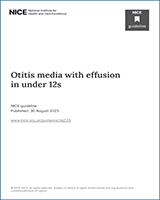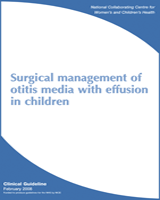Excerpt
Otitis media with effusion (OME) is a condition characterised by a collection of fluid within the middle ear without signs of acute inflammation. It is most common in young children, with a bimodal peak at 2 and 5 years of age. Eighty percent of children will have had a least one episode of OME by the age of 10 years. At age 7–8 years, about 8% of children will have middle ear effusions; this incidence increases in winter. The mean duration of effusions is 6–10 weeks but some cases are more persistent.
OME is known to be a fluctuating condition with symptoms that vary with time and with age. The main symptom of OME is impaired hearing because the middle ear effusion causes a conductive hearing loss by reflection of the sound energy at the air–fluid interface. The diagnosis is based on suspicion of hearing loss, clinical history, clinical examination of the ears and appropriate audiometry and tympanometry.
While most cases of OME will resolve spontaneously, some children will need intervention because of the effects of hearing loss. This intervention may take the form of educational and social action or the provision of a hearing aid to minimise the impact of the hearing loss. No non-surgical intervention has yet been shown conclusively to be of benefit. Surgical management usually takes the form of myringotomy and insertion of a ventilation tube (grommet), with or without adenoidectomy.
Children with cleft palate are particularly susceptible to OME because of the impaired function of the Eustachian tube that results from the palatal anomaly, which in turn leads to a failure of middle ear ventilation. Similarly, children with Down’s syndrome have a high incidence of OME, partly because of their impaired immunity and mucosal abnormality, with resulting susceptibility to ear infection. These groups of children need particular surveillance for OME so that proper action can be taken.
This guideline attempts to bring together the evidence related to surgical management of OME in children younger than 12 years, and to advise on best and safest practice; treatment decisions need to balance potential benefits against potential risks, reflecting the fact that the degree of benefit usually depends upon the severity and persistence of the condition.
While every effort has been made to ensure the accuracy of the information contained within this publication, the publisher can give no guarantee for information about drug dosage and application thereof contained in this book. In every individual case the respective user must check current indications and accuracy by consulting other pharmaceutical literature and following the guidelines laid down by the manufacturers of specific products and the relevant authorities in the country in which they are practising.


